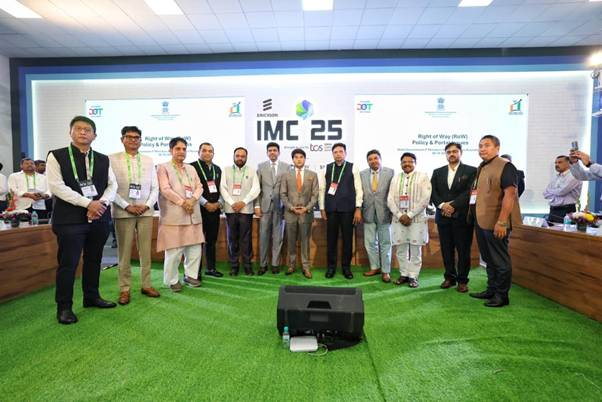Centre–State Roundtable Charts Roadmap for Accelerating India’s Digital Future
Minister of State Dr. Chandra S. Pemmasani spotlighted the critical role of the Telecommunication Right-of-Way Rules 2025, which aim to simplify and expedite network deployment across the country.

- Country:
- India
In a significant step toward strengthening India’s digital transformation agenda, Union Minister of Communications Shri Jyotiraditya M. Scindia, along with Minister of State for Communications Dr. Chandra S. Pemmasani and Secretary (Telecom) Dr. Neeraj Mittal, chaired a high-level Roundtable Conference with State IT Ministers and IT Secretaries on the sidelines of the India Mobile Congress (IMC) 2025.
The Roundtable served as a strategic platform for Centre–State dialogue, aimed at fostering cooperation and accelerating the development of digital infrastructure, expanding broadband connectivity, and strengthening the digital public goods ecosystem across India.
Driving Cooperative Federalism in the Digital Age
Setting the tone for the deliberations, Minister Jyotiraditya Scindia underscored India’s emergence as a global digital powerhouse, driven by rapid growth in internet access, broadband penetration, and affordable data. He emphasized that the success of India’s digital revolution lies in cooperative federalism, where both the Centre and States act as co-architects of progress.
“India has risen like a phoenix in telecom, digital inclusion, and equipment manufacturing on the world stage. Our journey from being regulators to becoming facilitators is enabling us to deliver connectivity, inclusion, and equity to every citizen,” Shri Scindia said.
He noted that India’s digital economy is projected to contribute nearly 20% to the national GDP by 2029–30, reflecting the central role of technology in economic transformation. The Minister called on States to align their digital policies with national frameworks, accelerate Right-of-Way (RoW) clearances, and replicate successful models of rural and last-mile connectivity.
Highlighting several state-led digital initiatives, Shri Scindia praised innovative models such as digital service centers, community Wi-Fi programs, and rural broadband entrepreneurship schemes, encouraging States to adopt a cross-learning approach.
“We must seize this opportunity together to build a resilient, inclusive, and future-ready digital ecosystem that reaches every corner of India,” he added.
Right-of-Way Reforms: Unlocking the Next Wave of Connectivity
Minister of State Dr. Chandra S. Pemmasani spotlighted the critical role of the Telecommunication Right-of-Way Rules 2025, which aim to simplify and expedite network deployment across the country.
He elaborated on key features of the new RoW framework, including:
-
Single-window clearances to streamline administrative processes;
-
Time-bound approvals to accelerate infrastructure rollout;
-
Uniform cost-based charges for right-of-way permissions;
-
Infrastructure sharing provisions to optimize existing assets; and
-
Integration of digital corridors into urban and regional planning frameworks.
Dr. Pemmasani urged States to operationalize these reforms swiftly, noting that the success of the National Broadband Mission 2.0 (NBM 2.0) depends on timely execution and coordination at the ground level.
“History will not ask whether we had the technology—it will ask whether we had the will. The vision of universal, affordable, and high-quality broadband under National Broadband Mission 2.0 is within our reach. The Telecommunication Right-of-Way Rules 2025 give us the means to realize this vision,” he asserted.
The Minister also emphasized the need for collaborative data sharing, real-time monitoring dashboards, and policy alignment between State and Central agencies to ensure that digital connectivity reaches every citizen seamlessly.
States as Key Enablers of India’s Digital Transformation
Dr. Neeraj Mittal, Secretary (Telecom), highlighted that while telecom is a central subject, its implementation rests primarily with the States. He emphasized that state-level coordination is essential to overcome ground-level challenges such as land acquisition, site access, and law and order issues that affect telecom infrastructure rollout.
“Nothing can happen without State cooperation on the ground. While policy is made at the Centre, its success depends on how efficiently it is implemented by States. This forum is invaluable for feedback and coordination,” Dr. Mittal stated.
He also noted that telecom infrastructure is a horizontal enabler that supports multiple sectors—including education, healthcare, logistics, and agriculture—and that its expansion directly contributes to inclusive growth.
Key Themes Discussed
The Roundtable’s deliberations revolved around the following key areas:
-
Accelerating 4G and 5G rollout in rural and remote regions to bridge the digital divide;
-
Adoption of indigenous telecom technologies and support for domestic manufacturing;
-
Policy harmonization between Centre and States to streamline digital governance;
-
Strengthening the digital public goods ecosystem, including platforms like Aadhaar, UPI, and India Stack;
-
Building secure and resilient digital infrastructure to safeguard data and ensure continuity; and
-
Encouraging private sector and start-up participation in last-mile connectivity projects.
The discussions also highlighted the role of public-private partnerships (PPPs), innovative financing models, and state-level regulatory sandboxes in enabling faster technology deployment and citizen-focused service delivery.
Commitment to a Shared Digital Future
The conference concluded with a joint commitment from the Centre and States to work collaboratively toward a robust, secure, and future-ready digital India. Participants agreed to establish joint review mechanisms, state coordination cells, and knowledge exchange frameworks to monitor progress and share best practices.
The deliberations reinforced the message that India’s digital journey is a collective national mission—one that requires synchronized action between all levels of government to ensure inclusive, affordable, and equitable access to digital services.
India Mobile Congress: A Platform for Digital Policy Convergence
Held as part of India Mobile Congress 2025, South Asia’s largest digital technology forum, the Roundtable was one of several strategic dialogues designed to shape India’s digital future. The IMC serves as a convergence point for policymakers, industry leaders, start-ups, and academia, fostering collaboration across the telecommunications and technology ecosystem.
By bringing together policymakers from across India, the Roundtable reaffirmed the nation’s collective resolve to build a globally competitive digital economy powered by innovation, connectivity, and inclusivity.










